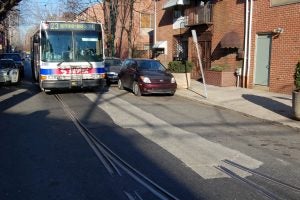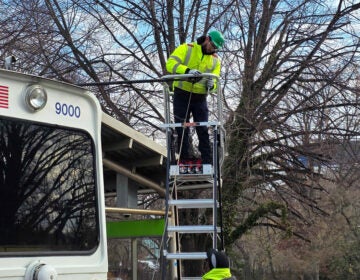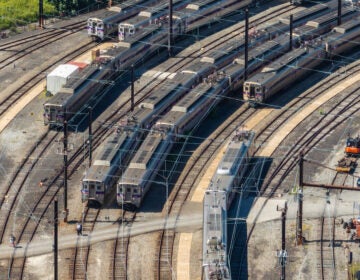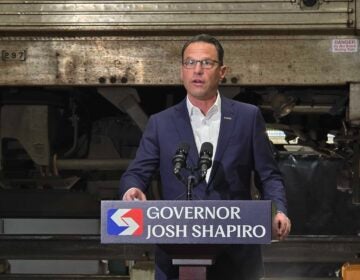Why “slippery rail season” ruins your commute

Note: It’s that time of year again, when the leaves change color and blanket the ground in a variegated cover. This is a repost of an article we ran November 6, 2015, explaining how all that crunchy old vegetation wreaks havoc on the region’s rail infrastructure. It was also written when the then-editor of PlanPhilly allowed, even encouraged, lots of mediocre jokes.
Streetsplainers is an occasional series where we seek out answers to those often overlooked questions about our beleaguered/beloved transportation systems: Just what the heck is that thing in the road? Why on Earth would SEPTA do that? How does that weird doohickey work? E-mail Jim Saksa your questions, and he’ll chase down the answers, hopefully in a reliably on-time fashion.
It’s November, so we’re smack dab in the middle of what SEPTA calls slippery rail season and PATCO calls leaf season.
At the Thanksgiving dinner that is public transit in the Delaware Valley, SEPTA would clearly be your chardonnay-sipping aunt from Chestnut Hill who insists on saying autumn to your Bud-chugging uncle who doesn’t seem to notice how loudly Bernice sighs every time he talks about the fall in South Jersey.
But what’s in a name? That which we call an express would run as late.
Semantics aside, what’s slippery rail season? Well, the trees ‘round here tend to shed their colorful plumage in October and November, blanketing high speed lines, regional rails and trolley tracks alike in a sometimes dazzling array of delay-causing color.
When passing trains crush leaves, they leave (the puns write themselves, folks!) an oily residue on the rails. In great enough numbers, the leaves coat the rails to cause slippage.
Call it the banana peel effect.
There isn’t a ton of friction between steel rails and steel train wheels to begin with. “It’s what makes trains more efficient,” said PATCO General Manager John Rink. “There is less resistance to begin with, and this residue reduces friction even more.”
Left unchecked, braking trains would skip instead of stop, and accelerating trains might spin in place.
To compensate, PATCO trains slow down heading into stations a bit sooner, and accelerate a bit slower, said PATCO’s Assistant General Manager Bennett Cornelius, who said it’s no different than driving your car in snow or ice. “Same thing with trains,” he said in an email.
“I know from experience it’s the same thing with a motorcycle,” he wrote rather surprisingly for a Bennett who works in public transportation.
Cornelius then signed off his email with “#JustSayin”, confirming that you really can’t make assumptions about people because of their profession or patrician-sounding name.
Like their South Jersey cousins, SEPTA also adjusts train speeds on routes exposed to the outdoors. Both transit agencies regularly clean their rails to mitigate the impact. SEPTA also uses pressure washers on regional rail, and employs a “combination of water, gel, and sand to remove oily deposits on the tracks,” says Kristin Geiger, a spokesperson for SEPTA. Oddly enough, Jersey-based PATCO does not use gel, instead relying on metal brushes and pressure washers to clear their rails of leafy residue.
When asked, PATCO GM Rink said that building nets over the rail lines would cost a lot of money that’s needed elsewhere.
Besides the obvious safety risks, slippage can damage the wheels, flattening the edges. Train wheels can be trued by grinding them back into circles a few times, but after a while need to be replaced.
Slippery Rail Season cannot last forever. The cosmic ballet goes on, and the brilliant scarlet and amber hues shall soon give way to shades of barren gray and hushed white. And with it, that dreaded scourge of transportation systems the temperate world over: Adverse Winter Weather Conditions.
Now, you might be thinking: “Public transportation officials hate falling leaves, they hate snow… do they hate the joyous sound of music, too?”
Why, of course not! You can even busk in SEPTA stations, provided you fill out the necessary permits in advance and strictly comply with the promulgated regulations-there are only 15 or so.
VIDEO BONUS: SEPTA’s Geiger shared a YouTube video starring rail vehicle mechanical specialist Ed Carruthers explaining slippery rail season and showing its leaf-cleaner in action.
The video, dated November 4, 2013 ends with “Check Back in November for Part 2” but, as far as I can tell, no Part 2 exists. Maybe it’s a subtle allusion to how Mel Brooks ended “History of the World: Part I”? If so, I look forward to upcoming SEPTA videos like “Blazing Straphangers” and “Silent Car”.
WHYY is your source for fact-based, in-depth journalism and information. As a nonprofit organization, we rely on financial support from readers like you. Please give today.







